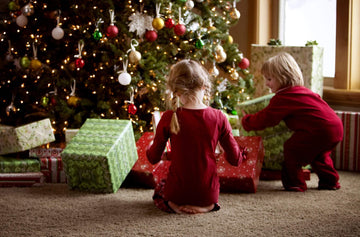With the holidays just around the corner, you might be making plans to celebrate Christmas or the New Year with the thought that this would be a well-deserved break for you and your children. However, the disruption in their routine, the increased sugar consumption and the multitude of gifts can make the holidays or any festival an overwhelming time for young children. Gifts are an intrinsic part of celebrations and you might have experienced embarrassing situations where your child displayed outward disappointment at receiving a gift that they didn’t like or walked off without even thanking the gift giver. Or maybe you didn’t know how to react when your child demanded gifts from everyone they met or visited your home. Some parents might have seen their child grab gifts from their relatives or tear open the beautiful packaging it came in and then throw a tantrum they realized that it is not what they wanted. Gift giving and receiving are wonderful aspects of the holidays but can also be tricky for children. Here are some tips and ideas on how to prepare and help your children through the art of giving and receiving gifts.

- Role Model
Children learn from our actions far more than they do from our words. Only if they see us demonstrate grace and courtesy will they imbibe it into their personality. We must make sure to outwardly express our gratitude for the gifts we receive by talking less about the gift itself but more about the person who gave us the gift and how much they mean to us. We must extend this courtesy of saying please and thank to not just adults but also to our children when they do something for us. By doing this we give out children the message that every person is important because of who they are rather than what they give us.
- Look for the good
We can tell children that even if they don’t like the gift they have been given, they still can look for something good in it. For example – even if they don’t like the toy, they could have read about it, seen it somewhere or have a friend who also has it. They could use this to thank their gift giver. This teaches them to look for the good and thank someone earnestly without lying. You can practice this with your child by coming up with funny, odd or weird hypothetical gifts they could receive and coming up with something nice to say about those. You can also tell you children that sometimes all they need to do is smile and say ‘thank you’. It is also to be understood that while children can always be taught to smile and thank people upon receiving a gift, they do not fully understand gratitude. Children do not comprehend perspective-thought till they are eight or sometimes even older. The best you can hope for at this point in their development is basic manners, politeness and an emulation of gratitude till it matures into the real thing.
- Privilege and expectations
We need to help children understand that receiving gifts is a privilege they should cherish and honour. They also need to understand that not all children in the world have this privilege. Unfortunately, children are unassuming recipients of messages of commercialism in the form of advertisements, visits to the mall, peer pressure and social media. Add lack of understanding of money limits to the mix and you are left with a child who thinks that it is natural for them to own everything they desire. To counterbalance this, you can begin by introducing the concept of money, set financial limits for their gifts and stagger gifts on their wish-list between holidays.
- The joy of giving
A very concrete and experiential way for children to understand the gifting is to be on the other side of it. You can introduce children to the idea of giving gifts , thereby demonstrating the time, effort and thought that goes into buying gifts for people. Involving your child in all the processes that go into giving gifts gives you an opportunity to model right behaviour and actions as well as provide a fun activity for them. Right from selecting the right gift for the person, going to a store and buying it to selecting the wrapping paper, hand-wrapping it and writing the gift card, your child can be a part of the entire process. Approaching them for ideas for gifts that they think would be suitable for other people gives them a sense of importance; it also creates the eagerness to learn what the receiver thought of their choice of gifts, thereby also teaching them that other people would be just as curious to know what they thought of their gifts. Their participation in the overall process makes them realize the amount of fun, time and effort involved in it, thereby making them better gift-receivers.







